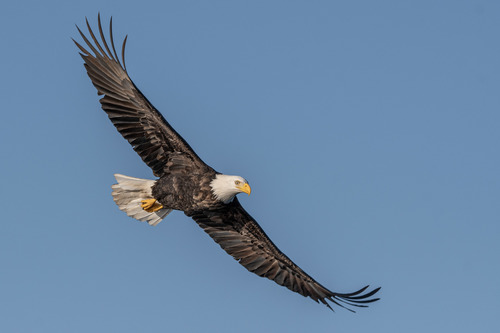
Bald Eagle
The Bald Eagle (Haliaeetus leucocephalus) is a majestic bird of prey found in North America, renowned as the national symbol of the United States. It is a large, powerful raptor known for its distinctive white head and tail contrasting with a dark brown body. Bald Eagles play a crucial role in their ecosystems as apex predators, primarily feeding on fish. Their recovery from near extinction in the 20th century is considered a major conservation success story. The Bald Eagle holds significant cultural importance, representing strength, freedom, and resilience.
70-102 cm
Length
168-244 cm
Wingspan
Least Concern
Conservation Status
Distribution
Bald Eagles are found throughout North America, ranging from Alaska and Canada to northern Mexico. They are often found near large bodies of open water with abundant food sources and old-growth trees for nesting. Migratory patterns vary; northern populations typically migrate south for the winter, while southern populations may be resident year-round. They can be found at various altitudes, from sea level to higher elevations.
Lifespan
Wild: up to 28 years; Captivity: up to 50 years (though this is exceptional).
Bald Eagle's Habitat
Habitat Types
Coastal areas, Rivers, Lakes, Reservoirs, Marshes
Climate Zones
Temperate, Subarctic, Subtropical
Adaptations
Bald Eagles have excellent eyesight, adapted for spotting prey from great distances. Their powerful talons are perfectly suited for catching and holding slippery fish. They also have specialized feathers that provide insulation in cold climates.
Variations
Two subspecies are generally recognized: *H. l. leucocephalus* (southern bald eagle) and *H. l. alascanus* (northern bald eagle). The northern subspecies is typically larger.
Appearance
Breeding Plumage
Adults have the characteristic white head and tail, and dark brown body. Juveniles are mostly brown with mottled white markings and gradually acquire adult plumage over 4-5 years.
Seasonal Feather Changes
There aren't significant seasonal variations in adult plumage beyond general wear and tear.
Sex Based Plumage Differences
Adult males and females have similar plumage.
Notable Features
White head and tail feathers (in adults), Large, hooked yellow beak, Powerful yellow talons, Large size
Diet and Feeding
Primary Foods
Fish, Waterfowl, Carrion, Small mammals
Foraging Behavior
Bald Eagles primarily hunt by soaring high above the water and swooping down to catch fish with their talons. They also steal food from other birds (kleptoparasitism) and scavenge on carrion, especially in winter.
Specializations
Their excellent vision allows them to spot prey from considerable heights. Their talons have spicules (small, sharp projections) that help them grip slippery fish.
Seasonal Diet Variations
Diet can vary seasonally depending on prey availability. In winter, they may rely more on carrion and waterfowl when fish are less accessible.
Behavior
Social Structure
Generally solitary or in pairs, but can congregate in large numbers at abundant food sources, especially during winter.
Communication
Vocalizations (high-pitched whistles and calls), Visual displays (posturing, aerial displays)
Migration
Northern populations are migratory, moving south in the fall to find open water and food. Southern populations may be resident or only make short-distance movements.
Territorial or Group Behaviors
Bald Eagles are territorial during the breeding season, defending their nesting area. Outside of breeding, they may tolerate closer proximity to other eagles, especially at good feeding locations.
Conservation
Threats
Historical use of DDT (pesticide causing eggshell thinning), Habitat loss (deforestation, shoreline development), Lead poisoning (from ingesting lead shot in carrion), Collisions with vehicles and power lines, Human disturbance
Protection Programs
Banning of DDT, Endangered Species Act (USA) - now delisted but still protected, Migratory Bird Treaty Act (USA), Habitat restoration and protection efforts
Local National Laws
Protected under the Bald and Golden Eagle Protection Act (USA) and various state and provincial laws.
Population Trend
Increasing
Population Estimates
Estimated at over 300,000 individuals in North America.
Interesting Facts
Bald Eagles build the largest tree nests of any bird species.
Nests can be massive, reaching up to 4 meters (13 feet) deep and 2.5 meters (8 feet) wide, weighing over a ton.
Bald Eagles can fly at speeds of up to 65 kilometers per hour (40 mph) during level flight.
They can reach much higher speeds when diving for prey.
The Bald Eagle was removed from the U.S. Endangered Species List in 2007.
This was due to successful conservation efforts, including the banning of DDT and habitat protection.
Bald Eagles are not actually bald.
The name comes from an older meaning of the word 'bald,' which meant 'white-headed.'
Faqs about Bald Eagle
What do Bald Eagles eat?
Bald Eagles primarily eat fish, but they also eat waterfowl, carrion, and small mammals.
Where do Bald Eagles live?
Bald Eagles live throughout North America, near large bodies of water with abundant food and tall trees for nesting.
Are Bald Eagles endangered?
Bald Eagles were once endangered in the United States but have made a remarkable recovery and are no longer listed as endangered. However, they are still protected by law.
How long do Bald Eagles live?
Bald Eagles can live for up to 28 years in the wild, and even longer in captivity.
How can I tell the difference between a male and female Bald Eagle?
Females are generally larger than males, but otherwise, their plumage is similar. Size is the most reliable way to distinguish them when seen together.
Copyright @ Nature Style Limited. All Rights Reserved.
 English
English